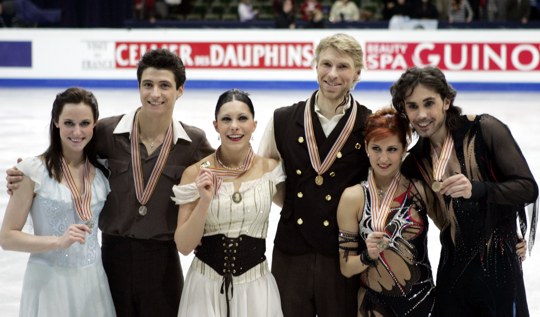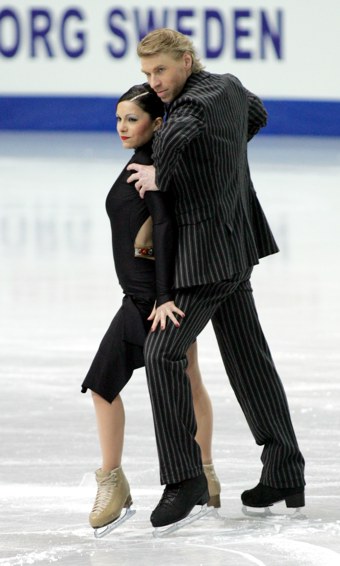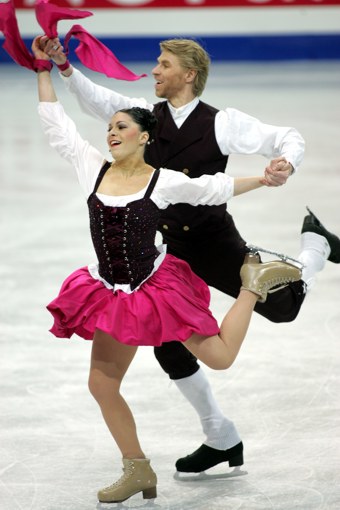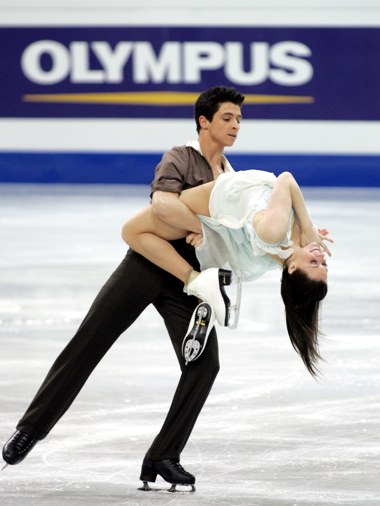|
The Dance event may well have ended before the compulsory dances were even completed. In the second warm-up Tanith Belbin fell out of control in the twizzle in the second pattern. Up until that point they were skating quite well, with a precise execution of the step, though perhaps a bit stiff overall. But after the leg kick where the man turns from forwards to backward and the lady twizzles, Belbin when flying out of control. Fortunately she did not pull Agosto down, so so the fall cost the team only one deduction, but also a loss of at least 1.64 points in that section of the dance. Where it not for this error, the team would have finished in the top three. Given the field at this competition it was viewed at the start of the competition that this year was their best chance to take home the gold. Though it was not expected that they would win the CD, it was though they would remain close enough that their greater strengths in the Original Dance and Free Dance could carry the day. But after the CD they find themselves 5.71 points out of first place and 2.96 points out of the medals. The only silver lining in this is that in PCS they were scored second best, which leaves hope they can pull up to a medal of some sort. The other favorite at the start of the event, Isabelle Delobel & Olivier Schoenfelder had an excellent skate. The had deep edges, precise steps and an outstanding effortless expression, earning component marks above 8 for Skating Skills, Performance and Interpretation. Though only 5.71 points, for dance they currently appear to have a commanding lead after the CD. Skating 30th out of 31, Canadians Tessa Virtue & Scott Moir, another team with high expectations coming into the competition, placed second. They were marked second best in TES and third best in PCS. Their GoEs were mostly ones and twos, with one minus one and a few zeros. In components they were scored uniformly well, with marks in the mid-sevens. hey are currently sitting in good position for a medal here. In third place, the second ranked Russian team (after Dominina & Shabalin) are nipping at the heels of the Canadians, less than one point behind. They also were scored with mainly ones and twos in the elements. They hold a slim lead over the fourth place team of Federica Faiella & Massimo Scali of 0.83 points, so the scramble for silver and bronze looks like it will be intense in the subsequent segments of this event. In a virtual tie for sixth place, Meryl Davis & Charlie White are in seventh place at 34.80 points, vs. 34.82 points for the Fench team of Nathalie Pechalat & Fabian Bourzat. These two couples as well as Belbin & Agosto are clustered near 35 points and are mathematically in the running to medal, but only Belbin & Agosto have a realistic chance to do so. Davis & Whites main job here is to better there placement from 2007 and to place high enough to help the U.S. keep three spots for next season. The third U.S. team of Kimberly Navarro & Brent Bommentre placed 12th, and skated confidently despite the difficulties they have had to overcome due to Bommentre's skates and costumes being lost in transit. Bommentre performed on a new pair of skates he has never used before, brought over at the last minute by a student of his who left for Sweden after the team arrived here. The team was also able to find clothing in town that fit Navarro's dress well, and if one did not know the back story there was no sign from their skating that anything was up. For the Original Dance, the costume repair volunteers here have been taking costume repair to new levels, by helping Bommentrer to come up with an entirely new costume in time for the OD on Thursday.
Delobel & Schoenfelder |
||||||||||||||||||||||||||||||||||||||||||||||||||||||||||||||||||||||||||||||||||||||||||||||||||||
Original Dance
Folk
|
The Original Dance this year is a general Folk/Country dance, allowing the couples to select any rhythm of folk or country origin. Consequently, teh OD this years has a wide variety of styles and interpretations compare to when only one designated rhythm is permitted. The French couple skated French country dance known as a Gavotte. This is a dance of Basque origin in duple meter (usually two, but any even number of beats per measure). Dressed in fuchsia and burgundy, it was a cutesy dance skated with moderate speed. The dance was exceptionally well receive by the judges, with GoEs of mostly ones and twos, with only one zero and a few threes. Their elements were all level four, and their component marks were in the mid eights with two judges going into the nines -- phenomenally high component marks, for the current marking standard used by the judges. The French couples lead had been 2.02 points after the short, but a strong effort by Khokhlova & Novitski reduced that to 1.26 points. The Russian couple skated a Russian gypsy dance that also was scored with GoEs of mainly ones and twos, with only one zero and a few threes. There TES, in fact was scored ahead of the French team by 0.37 points. The levels of their elements were also all called level 4. In PCS, however, they trailed Delobel & Schoenfelder by 1.63 points, with component marks in the high sevens to low eights. They trailed the French team in all components, but particularly in Skating Skills and Movements (the dance equivalent of Transitions). Their dance was well skated, with moderate speed and good expression. Tessa Virtue & Scott Moir dropped to third in the OD and third overall. They currently now 0.45 points behind the Russians and 2.82 points ahead of the fourth place couple. The Canadians skated a generic Russian folk dance which was scored with GoEs ranging from zero to three, mostly in the ones and twos. Their elements were called level 4 except for the twizzles in the midline not touching step sequence, which were called level 3. In PCS, they were scored only 0.09 behind Khokhlova & Novitski. Their routine was well skated and was notable for the element of "oneness" that is essential for a dance couple (and pair team). Federica Faiella & Massimo Scali dropped to fifth in the OD, but scored well enough to hold fourth place overall. Their elements were all called level 4, and were scored with GoEs of mainly ones and two, but received no threes from teh panel. It was a decent skate, with moderate speed, but the performance dod not connect with the audience the way the higher placed couples did. Their component marks were mainly in the mid sevens. Tanith Belbin & Benjamin Agosto made little progress in attempting to move up to a medal. The beat the Italian team, to place fourth in the OD, but remain in fifth overall. Worse, in terms of points they lost ground and are now 3.81 points behind third place. There elements were all called level 4 and scored with GoEs of mainly ones and twos. It was a lively skate, and Agosto was particularly energetic, but one wonders if the "aw shucks" western-themed waltz was something a primarily European panel could relate to. Nevertheless, their component marks where in the high sevens to low eights. Attempting to read the tea leaves from this event, it looks like the Americans have little chance for the gold , but still have a shot at the silver or bronze. The couple will be skating last in the Free Dance, putting their fate firmly in their own hands. Meryl Davis & Charlie White held seventh in the OD and remain in seventh overall. The couple's dance is another generic Russian folk dance which is engagingly performed by White. Their combination spin was called level 2, and the remainder of the elements level 4. GoEs were mainly in the ones and twos. Their component marks were mainly in the low sevens. The couple seems to be firmly ensconced in seventh place for this competition. Kimberly Navarro & Brent Bommentre dropped one place in the OD, but maintained their overall position in twelfth place. Skating an African folk dance, their routine was nicely skated, with enthusiasm, with no sign of pressure, eitehr from being at worlds, or their week long ordeal to obtain a backup pair of skates and costumes. Their rotational lift was called level 2, while the remaining elements were called level 4, and tier GoEs were mostly zeros and ones wthe a handful of twos and minus ones. There program components were marked in the upper fives to low sizes. They trail the eleventh place team by nearly fi ve points, so their is little up-side potential there, and the team behind them is niping at their heels 1.58 points back.
Delobel & Schoenfelder |
|||||||||||||||||||||||||||||||||||||||||||||||||||||||||||||||||||||||||||||||||||||||||||||||||
Free Dance
|
Skating to music from the soundtrack from "The Piano", the couple skated a "high concept" program. It must have been high concept because it required a handout to explain what it was about. The performance was generally well skated, though there were a few sloppy steps, the most obvious of which was a stumble by Schoenfelder at the end of their circular step sequence. It was a well choreographed program with outstanding interpretation -- six of the judges on the panel went to marks of 9.00 for the Interpretation mark. The French couple were scored best in PCS, but they gave up a point to Tessa Virtue & Scott Moir in TES. Their elements were called level 4 except for their dance spin at level 3. Even so, the French base value was higher than the Canadian couple, with the difference between these two teams in the quality of execution. Virtue & Moir, skating to music form "The Umbrellas of Cherbourg", gave a precise, technically excellent performance. This was reflected in their GoEs which were mainly twos and threes, with a handful of ones. Like the French teams all there elements but one were called level 4, with one at level 3 -- a diagonal step sequence. Though well presented, they did not quite sell the story of their program as well as the French couple. But we are splitting hairs here, with Virtue & Moir still being scored in components in the mid to upper eights, with the Canadian judge (we assume) scoring them with three 9.00s. It would appear that judge number 1 was the Canadian judge (scoring the Canadian couple up and the French team down, and judge number 3 was the French judge scoring the French couple up and the Canadian couple down. Tanith Belbin & Bengamin Agosto made a valiant attempt to overcome Belnin's fall in the Compulsory Dance. They moved up to third in the Free Dance and fourth overall. They missed out on the bronze medal by 0.26 points. Overall the routine was well skated, though lacked speed in the first half. The elements for the Americans were called level 4 except for a circular step sequence which was level 3. Their GoEs were mainly ones and twos, with a few threes, but also one zero and one minus one. The negative GoE was from judge number 3 (the French judge ?) for their rotational lift. The lift had one momentary wobble of Agosto's arm (if that is even the right word for it). While judge 3 nailed them for it, the rest of the panel scored it with positive GoEs and two judges even went to plus three. Go figure. In PCS Belbin & Agosto were scored third best with marks in the low to mid eights. While the French and Canadian couples used "story" type programs, the American program was a more abstract interpretation of music by Chopin. Meryl Davis & Charlie White, moved up one place in the Free Dance to finish sixth overall. Their routine was also a "story" type program, in their case drawn from the the song "Eleanor Rigby" and "Eleanor's Dream." It was a nicely skated routine with both skaters working to develop the presentation, unlike their OD where it seems that White is doing most of the work. There elements were a mix of levels 3 and 4, and were scored with GoEs of mostly ones and twos. They received only one GoE of minus one -- from judge 3. (You remember judge 3, that's the judge we think is the French judge.) Six other judges, on the other hand, had that element at plus two! Kimberly Navarro & Brent Bommentre placed 14th in the Free Dance and 12th overall. Though it was a decent, clean skate, with elements at level 3 and 4, the performance lacked the passion and emotion called for by their music, "Since I've been loving you." Their program components were scored in the high fives and low sixes.
Tessa Virtue & Scott Moir |
|||||||||||||||||||||||||||||||||||||||||||||||||||||||||||||||||||||||||||||||
2008 Worlds Medalists
|
 |


